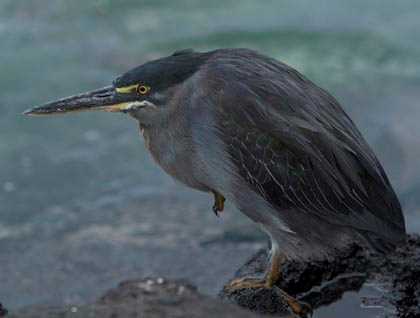After a long navigation from the central part of the archipelago, we woke up in the northern most part of Isabela Island. This area is a good place to search for cetaceans in the archipelago, and it was worth it even though we didn’t spot any whales or dolphins. Still, the light was beautiful and the ocean was very calm like glass. Pacific Ocean sun fishes instead made up for our morning activity along with flying fish as we kept sailing toward the south to cross the Equator line.
After our traditional celebration on the bow of the National Geographic islander, we finally arrived to Punta Vicente Roca on Isabela Island to continue our Galapagos exploration.
This place has fantastic dramatic formation with caves, lava dikes and tuff cones. This makes it the ideal resting and nesting spot for many sea birds such as: blue footed and Nazca boobies, frigates, Galapagos penguins, Galapagos cormorants, brown noddy terns, marine iguanas and Galapagos sea lions. Everybody went out for a well-organized Zodiac ride with our friendly and knowledgeable naturalist guides.
Our final morning activity took place in the same location, the water was pretty warm for this time of the year and the whole area was covered with friendly jellies because they did not sting any of our guests while in the water. The swim was worth it because we encountered a few dozen turtles, Galapagos cormorants and penguins and big aggregation of yellow tail and Galapagos mullets along with playful Galapagos sea lions.
For the afternoon we had to reposition our ship from Punta Vicente Roca towards Fernandina Island. On our way we had a general announcement from our expedition leader and we finally got to see a big pod of bottle nose dolphins and pilot whales. What an amazing sighting.
Very early in the afternoon we set foot on Fernandina Island, this big active volcano has just one visitor site and probably this place is the best to see Galapagos marine iguanas. We have seven populations of this endemic marine reptiles, and these are the largest among them all.
We also spotted Galapagos flightless cormorants, which is the best example of biological evolution in Galapagos.
On our way back onboard we observed a natural phenomenon which is known as the green flash. This only happens when you have the right atmospheric conditions in the sky and good karma.
We just had another fantastic day and are looking forward to more adventure tomorrow on Isabela Island. This Island is so big that has a lot to offer for our dear Galapagos visitors.







